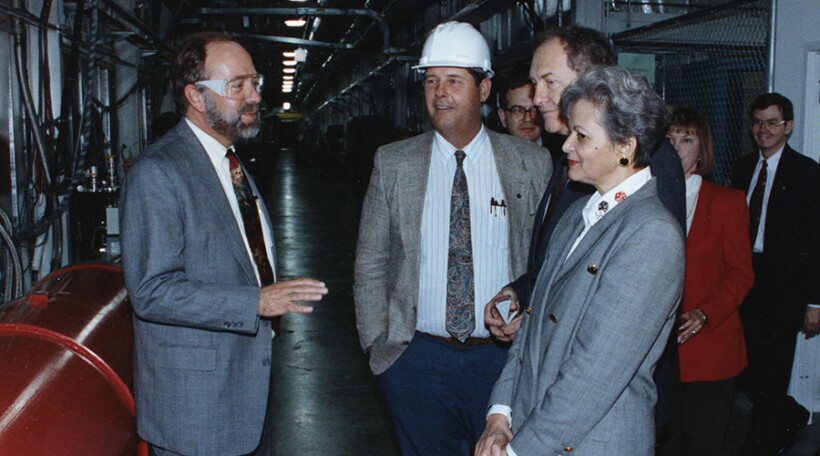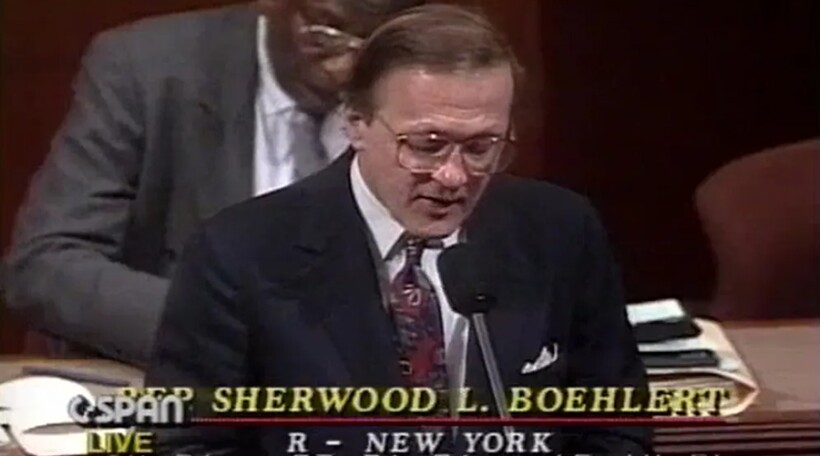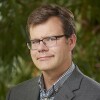The Superconducting Super Collider: Oral Histories

An event promoting the Superconducting Super Collider in the White House Rose Garden, March 30, 1988. Figures present include Secretary of Energy John Herrington (at podium), President Ronald Reagan (center), flanked by Steven Weinberg (left) and James Cronin (right), Samuel Ting (back row, left), and Burton Richter (back row, partly hidden).
Mary Anne Fackelman-Miner, The White House, courtesy of AIP Emilio Segrè Visual Archives
This feature will be updated as new interviews become available. It was last updated on April 3, 2025.
AIP’s oral history collection includes a significant number of interviews that offer different perspectives on the history of the Superconducting Super Collider. The SSC was a high-energy physics facility that would have far exceeded the collision energy of the Large Hadron Collider, the current world-leading facility that was eventually built at CERN. The SSC was proposed in the early 1980s and approved late in the Reagan administration. However, Congress terminated funding for it in 1993 amid a rising interest in budget control, shifting the global balance of leadership in high-energy physics to Europe.
Most of these interviews were conducted as background research for the 2015 book Tunnel Visions
Origins of the SSC
Proposals to construct a very large-scale particle collider, with an energy in the tens of TeV, date to the late 1970s. Advocacy for a US facility gained momentum with the introduction of the “Desertron” concept in 1982. The US Department of Energy’s Office of Energy Research decided to move ahead with the project in 1983 at the same time as it elected to terminate work on the beleaguered Isabelle collider at Brookhaven National Lab. Early work was conducted through an exercise called the Reference Designs Study and then a more intensive study conducted by a team called the Central Design Group, based in Berkeley, California.
George Keyworth (March 12, 2000)
In a wide-ranging interview, President Reagan’s science advisor recalls his opposition to proceeding with the Isabelle collider and his support for pushing ahead with a far more ambitious facility. He claims he had successfully lined up White House policy on the matter before he was directed to dedicate his efforts to Reagan’s Strategic Defense Initiative in 1983.
Read more
Doug Pewitt (May 3, 1998)
In an interview covering Pewitt’s involvement with the SSC during the various phases of its history, he recounts his time as a senior staff member at the White House Office of Science and Technology Policy. He notes his disagreements with George Keyworth and corroborates Keyworth’s claim to have lined up White House opposition to Isabelle in favor of the SSC project.
Read more
Maury Tigner (April 12, 2024)
Cornell University accelerator physicist Maury Tigner recalls the earliest proposals for the SSC, his involvement with the advisory panel that recommended moving ahead with the project, and his leadership of the SSC’s Reference Designs Study and Central Design Group. He offers his views on not being seriously considered for the role of SSC laboratory director.
Read more
Peter McIntyre (July 27 & Aug. 2, 2020)
A physics professor at Texas A&M University, McIntyre discusses the formation of the Texas Accelerator Center consortium and its advocacy of a superferric magnet design for the SSC that was not adopted. He also recalls efforts in Texas to lobby the Reagan administration via Vice President George H. W. Bush to pursue the SSC.
Read more
Christopher Llewellyn Smith (Feb. 18, 2010)
Llewellyn Smith, an Oxford University physicist who became CERN director-general, offers a European perspective on the US decision to proceed with the SSC. He recalls how the shifting political fortunes of the project influenced decision-making at CERN concerning construction of the Large Hadron Collider.
Read more
Approval and First Steps
Following the completion of the Central Design Group’s report, the Department of Energy received President Reagan’s approval to proceed with construction in 1987. Work began by selecting a contractor to manage the project, choosing the site where it would be built, and selecting the project’s management team.
Alvin Trivelpiece (Nov. 6, 1996)
Trivelpiece, who directed the Department of Energy’s Office of Energy Research from 1981 to 1987, recounts how he shepherded the SSC project from when he first allocated funding to it through to securing White House approval to proceed with construction. He recalls efforts to estimate costs and select a project site, as well as interactions with DOE leadership and members of Congress.
Read more
Robert Diebold (April 20 1995)
Diebold, a physicist and Department of Energy official, offers his perspective on the site-selection process for the SSC, including the strong merits of the Texas site that was chosen. He also reflects on DOE’s oversight of the project as it ramped up and the factors leading to increases in its estimated cost.
Read more
John Marburger (June 2, 2009)
Physicist John Marburger discusses his experiences as chairman of the Board of Trustees of Universities Research Association, the consortium responsible for managing the SSC project. He recalls URA’s successful bid to manage the project, the selection of Roy Schwitters as laboratory director, and the pressures surrounding the project leading up to its termination.
Read more
The Project Ramps Up

SSC Laboratory Director Roy Schwitters speaks with a visiting delegation led by Energy Secretary Hazel O’Leary.
AIP Emilio Segrè Visual Archives, Physics Today Collection.
The Department of Energy selected Waxahachie, Texas, as the site for the SSC in November 1988 and work commenced there in 1989. The project was bedeviled early on by difficulties in filling out its leadership and by increased cost estimates stemming from factors such as a change in the design of its magnets. Energy Secretary James Watkins, formerly the highest-ranking officer in the US Navy, recruited individuals with Defense Department backgrounds to impose tight oversight on the project.
Roy Schwitters (March 22, 1997 & March 31, 1998)
The SSC laboratory director reflects on his experiences leading the project, including relations with the Department of Energy and ineractions with key project personnel. He recounts the decision to redesign the aperture for the SSC magnets and the oversight that DOE imposed on the project in the face of the resulting increase in its cost estimate.
Read more
Doug Pewitt (May 3, 1998)
In his interview, Pewitt recalls his experiences working on the SSC project, including URA’s contract bid, his efforts at the site to implement a cost and schedule control system, and the project’s difficulties in hiring a project manager leading to his own brief service as acting project manager.
Read more
James Watkins (Feb. 2, 2000)
Energy Secretary Watkins discusses his lack of confidence in the Department of Energy to oversee large projects and his imposition of strong departmental oversight on the SSC in the wake of increases in its estimated cost. He stresses his support for the project and recalls difficulties in attempting to secure contributions from Japan.
Read more
Edward Siskin (June 2, 2000)
Siskin, recruited by Energy Secretary Watkins to manage the SSC project, recalls tensions between various leaders on the project and the growing hostility faced from Congress. He recounts difficulties in implementing cost and management controls but asserts that the project was stable by the time it was ultimately cancelled.
Read more
James Decker (June 8, 2023)
Decker, who became deputy director of the Department of Energy Office of Energy Research in 1985, discusses difficulties caused by Energy Secretary Watkins bypassing the office’s ordinary project oversight role. He also recalls the disruption to plans for the SSC caused by the Clinton administration’s imposition of a yearly cap on its budget.
Read more
William Happer (Feb. 15, 1997)
Happer discusses the SSC project from his perspective as director of the Department of Energy Office of Energy Research from 1991 to 1993. He reflects on Roy Schwitters’s leadership of the project, problems in securing contributions from Japan, and the ferocity of the SSC’s opponents in Congress. He suggests DOE’s oversight and the fate of the SSC were not unusual when regarded in the context of other large-scale DOE projects that were not scientific facilities.
Read more
Fred Gilman (May 20 & June 10, 2020)
Gilman, a theoretical physicist, recalls his recruitment to join the SSC in 1989 as its associate director for physics research and the changes it entailed for his career. He discusses the development of his division and confronting matters such as a proposal to reduce the SSC’s collision energy, selecting among particle detector proposals, and working under the Department of Energy’s oversight structure. He also reflects on the circumstances surrounding the SSC’s termination and on his work during the project’s close-down phase and afterward.
Read more
John Rees (Sept. 2, 2009 & May 6, 2010)
Accelerator physicist John Rees discusses his participation in the 1983 panel decision to proceed with the SSC and his work with the Central Design Group. He then recounts his recruitment to the SSC project in 1992 as its final project manager. He addresses the relations among the various leaders on the project and his efforts to implement a project management control system.
Read more
The Termination Decision

Rep. Sherwood Boehelert speaks on the floor of the House of Representatives against the Superconducting Super Collider, June 20, 1992.
C-SPAN.
Broad congressional interest in the SSC declined following the selection of Texas as its site, leaving an opening for a coterie of opponents to begin eroding support for its funding. They leveraged unstable cost estimates, a failure to secure substantial international contributions, and opposition from within the scientific community to portray it as poorly managed and a waste of money. Lukewarm support from the Clinton administration and strong congressional interest in budget cutting created an environment in which opponents could rally enough votes to deny the SSC funding to continue in fiscal year 1994, thereby terminating it.
David Goldston (Nov. 21, 1997)
A staff member for the House Science Committee’s Republican minority during the SSC debate, Goldston explains the campaign that Rep. Sherry Boehlert waged to maintain strict oversight of the project and to erode congressional support for it. He maintains Boehlert’s opposition was rooted in a belief the project did not justify its expense.
Read more
Howard Wolpe (Feb. 13, 1996)
Wolpe, the Democratic chair of the House Science Committee’s oversight subcommittee, discusses his skepticism of the SSC and how he and Rep. Boehlert, the subcommittee’s ranking Republican, used their investigative platform to build a case against the project. He remarks that Committee Chair George Brown, an SSC supporter, did not interfere in their work.
Read more
George Brown (Feb. 18, 1995)
Brown, a Democrat who chaired the House Science Committee in the early 1990s, discusses his support for the SSC and cites a failure to gain substantial international participation as a key factor leading to its loss of congressional support. He states that he was unpersuaded by claims about poor management on the project and suggests such accusations were not broadly influential in Congress.
Read more
Bennett Johnston (Feb. 14, 2000)
A Democratic senator from Louisiana, Johnston discusses his support for the SSC in his role as the lead Senate appropriator for the Department of Energy. He offers his views on the criticisms of the project and the political dynamics leading to its termination.
Read more
Phillip Anderson (May 29, 2002)
Anderson, a prominent condensed matter physicist, addresses the “mythology” that his congressional testimony was a key factor leading to the SSC’s termination. He also observes that he and other SSC opponents within the scientific community were incensed by misleading claims that were made about the spin-off benefits of high-energy physics.
Read more


